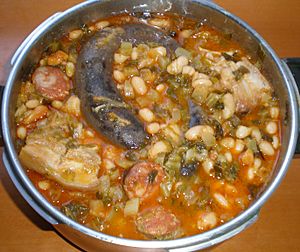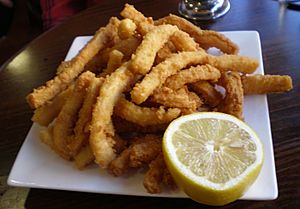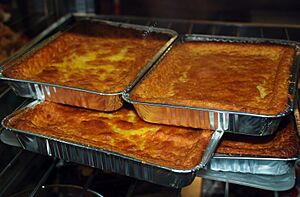Cantabrian cuisine facts for kids

Cantabrian cuisine is the delicious food from the Cantabria region in northern Spain. It uses fresh ingredients from the land and sea. You'll find amazing seafood from the Cantabrian Sea, like fish and shellfish. Rivers provide salmon and trout. The valleys offer fresh vegetables and dairy products. From the Cantabrian mountains, people get tasty veal and game meats. It's a mix of mountain and sea flavors!
Fish and Seafood Delights


Seafood is super important in Cantabria, especially from the coast and the Bay of Santander. You can enjoy all sorts of shellfish like clams, mussels, cockles, crabs, and lobster.
Popular fish include sea bass, hake, anchovy, and albacore. The albacore, also called bonito del norte, is used in a special dish called marmita or sorropotún. This is a hearty stew, often made with potatoes and fish.
Other famous Cantabrian seafood dishes are hake in green sauce (merluza en salsa verde) and squid with onions (maganos encebollados). Rabas are a very popular snack along the coast. These are deep-fried squid sticks, often enjoyed with a glass of white wine.
The processed anchovies from the town of Santoña are known worldwide for being very high quality.
Meaty Meals
Veal is a common meat, often from the local Tudanca cattle. Cantabria even hosts the biggest cattle fair in Spain, in a town called Torrelavega!
Game meats are also popular and tasty, like deer, roe deer, and wild boar. Pork is a key ingredient in the cocido montañés. This dish, which means 'mountain stew', is a hearty meal. It's made with beans, cabbage, and other yummy ingredients.
Sweet Treats and Dairy
Cantabria has many traditional pastries. Two very famous ones are the sobaos (a soft, buttery cake) and quesada pasiega (a sweet, cheesecake-like dessert).
Puff pastry is used a lot in different sweets. It has different names depending on where you are! For example, they are called corbatas in Unquera, polkas in Torrelavega, and sacristanes in Liérganes.
Other notable sweets include frisuelos and canónigos from Liébana. You might also find corazones from Liérganes, palucos from Cabezón de la Sal, and tortos and pantortillas from Reinosa.
Cantabria also makes delicious Dairy products. These include Cantabrian cream cheese and the strong picón Bejes-Tresviso cheese. There are also smoked cheeses, like those from Áliva or Pido. The Quesucos de Liébana are small cheeses made from a mix of cow and sheep milk.
See also
 In Spanish: Gastronomía de Cantabria para niños
In Spanish: Gastronomía de Cantabria para niños

